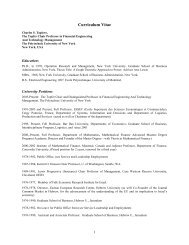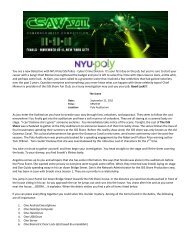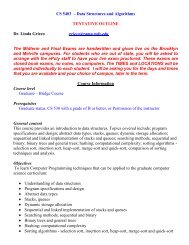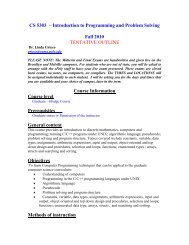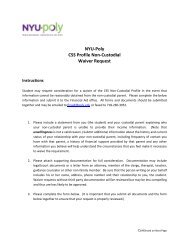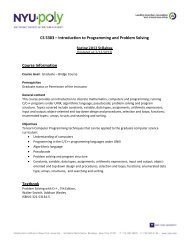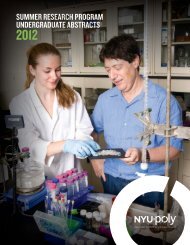Cable 2005 fall v1 - Polytechnic University
Cable 2005 fall v1 - Polytechnic University
Cable 2005 fall v1 - Polytechnic University
Create successful ePaper yourself
Turn your PDF publications into a flip-book with our unique Google optimized e-Paper software.
PolyThinking<br />
R. Raleigh D’Adamo:<br />
Putting Poly on the Map<br />
D’Adamo ’69ME is a problem<br />
solver. Looking back on his<br />
R.Raleigh<br />
career, he says, “It seems as though in<br />
just about every position I had, I either started<br />
something from scratch or took something that<br />
was very broken and fixed it.”<br />
The launching point for these accomplishments<br />
was a contest that the New York City Transit<br />
Authority ran in 1964 to create a new map for its<br />
subway system. Although he was working as a<br />
lawyer at the time, D’Adamo was inspired to try<br />
his hand at the contest by a lifelong interest in<br />
transportation and letterpress printing.<br />
The New York subway presents a unique challenge<br />
to mapmakers because it is the only system<br />
in the world where different lines extensively run<br />
on the same tracks. On a map, New York subway<br />
lines join up and split off from each other<br />
at different points, which makes it difficult to<br />
follow a line from beginning to end.<br />
To make things worse, New York had three<br />
different subway systems up until 1940, which<br />
were operated by two private companies and the<br />
city. When the city bought the other two systems,<br />
it produced three-color maps that identified<br />
subway lines on each system by a different color.<br />
With all of the subway routes in only three colors,<br />
the maps were very difficult to read.<br />
The innovation that D’Adamo proposed was<br />
to use more colors to represent the different lines,<br />
so it was easy to trace one line from beginning to<br />
end by following its color. He also abolished the<br />
antiquated perception that the subway system as<br />
a combination of three older systems. The transit<br />
authority agreed, and D’Adamo was one of<br />
three first-place winners in the contest.<br />
Winning the contest caused D’Adamo to give<br />
serious thought to a career change. He had<br />
always had an interest in transportation, and after<br />
the contest, he began to consider turning this<br />
interest into a career. However, his lack of formal<br />
training proved to be an obstacle. “As I went<br />
around looking for a job in transportation, no one<br />
would hire a lawyer,” he explained. “I was told to<br />
look into getting a grad degree in transportation,<br />
and the best place for that was <strong>Polytechnic</strong>.”<br />
He earned a master’s degree in transportation<br />
planning and engineering from Poly in 1969,<br />
and after that, many doors opened up. “All of<br />
the technical skills I learned at Poly stood me in<br />
good stead,” says D’Adamo. “There was always<br />
that sense of honesty and integrity. You knew<br />
you were dealing with real professionals.” He<br />
found a job with the City of New York Transportation<br />
Administration, and later worked for<br />
the Metropolitan Transportation Authority as<br />
head of the Office of Inspection and Review.<br />
In 1975, D’Adamo became commissioner of<br />
transportation for Westchester County, where he<br />
faced the challenge of building a bus system<br />
from the ground up. The bus system was such a<br />
success that in 1985, it was judged the most efficient<br />
system in the state by the New York State<br />
Department of Transportation.<br />
In 1986, D’Adamo became executive director of<br />
the Bi-state Development Agency in St. Louis,<br />
Missouri where he had to fight opposition to create<br />
a light rail line for the city. The agency’s board<br />
believed that the program would lose money, but<br />
D’Adamo maintained that if the agency didn’t<br />
build a rail line, another company would, and the<br />
agency would have to compete with them for riders.<br />
D’Adamo prevailed and St. Louis’ light rail<br />
line now serves more than 75,000 passengers per<br />
day. During his tenure at Bi-state, the agency<br />
earned a national award for innovation from the<br />
American Public Transit Association.<br />
In 1990, D’Adamo moved back east and<br />
became executive director of the New Haven<br />
Parking Authority. His most recent work was in<br />
Moscow with the New York City-based private<br />
engineering consulting firm STV Inc. He is now<br />
semi-retired and living in Pleasantville, New<br />
York, where he is an adjunct lecturer at Mercy<br />
College. He has been honored by the <strong>University</strong><br />
with the Second Century Award for Outstanding<br />
Professional Achievement, during Poly’s 125th<br />
Anniversary Celebration.<br />
R. Raleigh D’Adamo ’69ME<br />
The New York subway presents a unique challenge<br />
to mapmakers because it is the only system in the<br />
world where different lines extensively run on the<br />
same tracks.<br />
cable winter 2007 7




